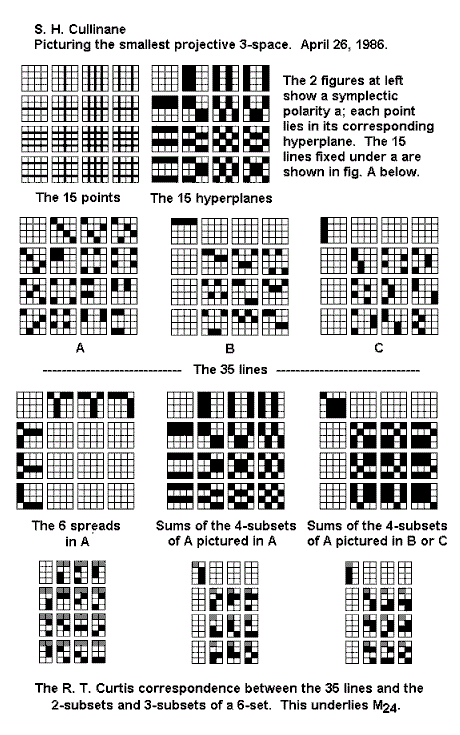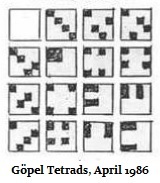
For some backstory, search Log24 for "Wolf Barth."
The German mathematician Wolf Barth in the above post is not the
same person as the Swiss artist Wolf Barth in today's previous post.
An untitled, undated, picture by the latter —
Compare and contrast with an "elements" picture of my own —
— and with . . .
“Lord Arglay had a suspicion that the Stone would be
purely logical. Yes, he thought, but what, in that sense,
were the rules of its pure logic?”
—Many Dimensions (1931), by Charles Williams
German mathematician Wolf Barth reportedly died
on December 30, 2016.
Flashback to this journal on that date * —
|
From "The Man Who Tried to Redeem the World with Logic" —
"The following June, 1945, von Neumann penned Image from von Neumann's report —
Version converted to text —
|
* And, of course, to the later post Easy E for Cullinan (Feb. 28, 2017).
Cullinan, second from left below, is the now-famous Oscars accountant.
For the title, see Icon Parking in a search for 54th in this journal.
For related iconic remarks, click on either image below.
This post was suggested by the Dec. 30, 2016, date of the
death in Nuremberg of mathematician Wolf Barth. The first
image above is from a mathematics-related work by
John von Neumann discussed here on that date.
See also Wolf Barth in this journal for posts that largely
concern not the above Barth, but an artist of the same name.
For posts on the mathematician only, see Barth + Kummer.
Some context for yesterday's post on a symplectic polarity —

This 1986 note may or may not have inspired some remarks
of Wolf Barth in his foreword to the 1990 reissue of Hudson's
1905 Kummer's Quartic Surface .
See also the diamond-theorem correlation.
The previous post's link to The Lindbergh Manifesto
and Thursday's post on Basel-born artist Wolf Barth
suggest the following —
See as well a June 14 New York Times
piece on Art Basel.
The logo of the University of Basel …
… suggests a review of The Holy Field —
The title of the previous post, "Slow Art," is a phrase
of the late art critic Robert Hughes.
Example from mathematics:

Click the Barth passage to see it with its surrounding text.
Related material:
Mathematics:
A review of posts from earlier this month —
Wednesday, September 4, 2013
|
Narrative:

Aooo.
Happy birthday to Stephen King.
From this journal on the above date — April 13, 2014 (Gray Space) —
Review of Seeing Gray , a book by pastor Adam Hamilton
of the United Methodist Church of the Resurrection
in Leawood, Kansas, a suburb of Kansas City—
“Adam Hamilton invites us to soulful gray space
between polarities, glorious gray space that is holy,
mysterious, complex, and true. Let us find within
our spirits the courage and humility to live and learn
in this faithful space, to see gray, to discern a more
excellent way.”
—Review by United Methodist Bishop Hope Morgan Ward
The above flashback was suggested by CBS Sunday Morning today —
See also Romanesque in this journal.
"Mr. Conrad was relentless and rigorous in expanding
the parameters of the fields in which he worked."
See also Spielfeld in this journal, as well as Conrad Moonshine.
Jennifer Jones,
film star and arts patron;
Tom Wolfe, author of
The Painted Word.
"Hunt for the best."
— Norton Simon

Cover detail,
soundtrack recording
of the Jennifer Jones film
"Angel, Angel, Down We Go"
The girl's left eye in the above
portrait illustrates a remark
in yesterday's New York Times
on a figure in a painting:
(This remark, by Michael Kimmelman,
comes with a headline–
Lights! Darks! Action! Cut!
Maestro of Mise-en-Scène
— that seems to have been inspired
by Tom Wolfe's prose style.)
For further details, see
Barthes's Punctum,
by Michael Fried.
Powered by WordPress